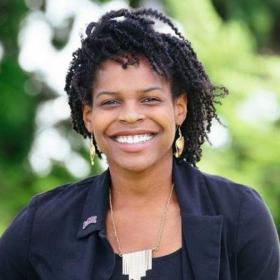
"Your zip code matters more than your genetic code."
These were the words of a guest speaker we had the privilege to hear from during our first National Health Corps (NHC) Chicago training. She was a physician from the University of Chicago who spoke about the detrimental effects of social inequality on the health of people of color in the city. It was this same speaker that inspired me to read The Warmth of Other Suns by Isabel Wilkerson, an epic that highlights The Great Migration (1915-1975) of black migrants as they moved to Northern and Western regions of U.S. fleeing the toxic and violent conditions of the South. Reading this book was one of the most impactful decisions I made during my service term because it provided me the lens through which I came to understand the complex history of Chicago neighborhoods. It revealed to me why the demographics of the red line train shifted from majority white commuters to black riders during my commute from my service site on the north side to my house on the south side. It illuminated to me the fact that there are people in Chicago that technically live on the same street but will never interact with one another due to the lingering consequences of racially restrictive housing covenants. Segregation is not a symptom of inequity unique to the city of Chicago but demonstrates a broader challenge facing major cities across the U.S. From asthma to diabetes, segregation has played an instrumental role in the augmentation of health disparities we see today. Today in our country, just as the guest speaker said,'your zip code matters more than your genetic code" when considering health outcomes.
When I first came to this realization it was both daunting and uncomfortable. Despite this discomfort however, I decided to employ my newfound knowledge as the framework I would use to serve my patients as a health educator. As a health educator I was tasked with educating patients about chronic illnesses and how to mitigate the effects of these diseases through lifestyle changes. Traditionally, this position would have consisted of me telling patients to exercise more and to eat more veggies, brown rice and chicken. Boom...we've eradicated diabetes in underserved communities *pats self on back*. However, upon closer observation through a health equity lense, I discovered this prescription was inept for historically marginalized populations. I thought more critically to help make a healthy lifestyle more accessible for the underserved, ethnically diverse patients I served at Heartland Health Centers in Albany Park (ironically, one of the most ethnically diverse zip codes in the United States).
Here were some of the my insights:
#1: Fruits and vegetables are perishable and tend to be more expensive in neighborhoods identified as low-income. Luckily there are programs for government food assistance recipients to receive discounts on fresh fruits and vegetables at local farmers markets and stores. However, people aren't always aware of these programs.
#2: Not every family eats brown rice and chicken. The U.S. is one of the most ethnically diverse countries in the world and we must to take this into consideration when making food lists and suggestions for a healthier plate. The U.S. Department of Health and Human Services and the CDC have recently developed cookbooks and resources to help address this, but this can always be improved and enhanced.
#3: Exercise is a privilege--the privilege of an able body, the privilege of a safe neighborhood, the privilege to afford a gym membership, and the privilege of time and child care. The traditional idea of going to the gym or walking around the park is not always an option for patients. So I learned to get creative with exercise ideas. For example, at-home YouTube Zumba sessions and games of hide-and-go-seek with grandchildren.
My patient interactions helped me glean the importance of considering the intersection of structural inequity and healthcare. Every day I was blessed with the opportunity to work with some of the most inspirational and resilient beings I had ever met. Many of my patients lacked insurance and were unable to afford their medication but still managed to reach their health goals. Some of them lost over 10 pounds while others lowered their hemoglobin A1c by 2 points. Despite their health being dictated by their zip code, they found the strength to take agency over their own health and prevail in the end.
Like the symbolic journey of the migrants of The Great Migration, marginalized communities are in pursuit of better opportunities and improved health. In order to assist these communities in this effort, it will be imperative that healthcare professionals recognize the unique challenges of these populations and the historical context related to their present conditions. Through empathy, humility and grace, I am confident we are capable of doing this. But the fight always has to be rooted in experiences of the community. I am so grateful to the mentors, patients and people of Chicago that have taught me these lessons. These stories of resilience will forever be kept close to my heart on my next journey to medical school.
Stay in love. -Lash

This blog post was written by NHC Chicago 2018-19 member Lash Nolen.
Lash is a Health Educator at Heartland Health Centers - Albany Park.
